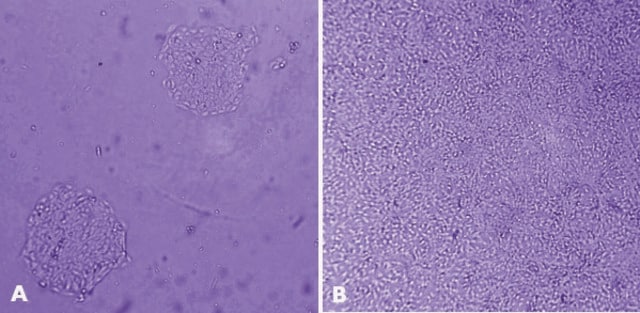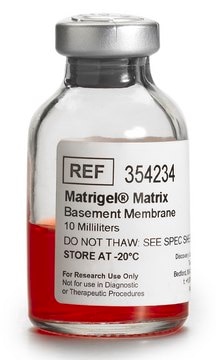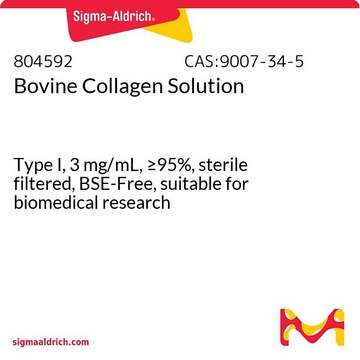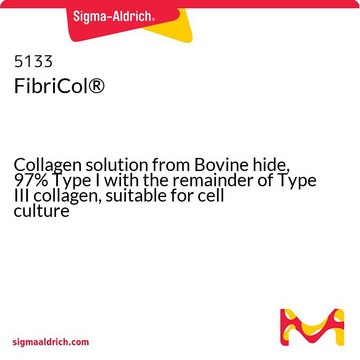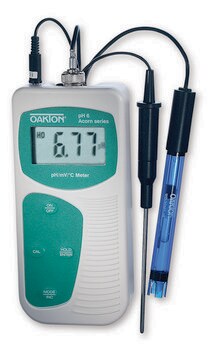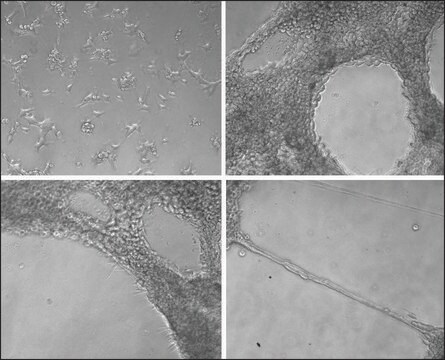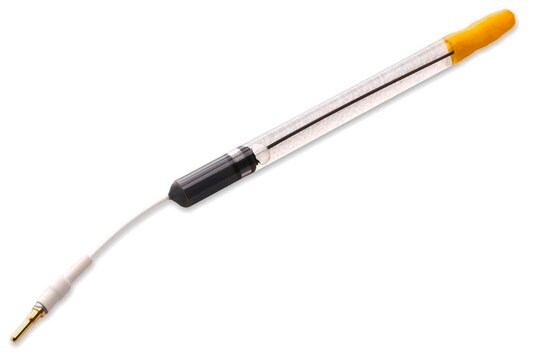5074
Bovine Collagen Type I
from bovine skin, liquid, 5 mg/mL, suitable for cell culture, used for 3D Hydrogel formation, PureCol™ EZ Gel
Synonym(s):
Collagen type
Sign Into View Organizational & Contract Pricing
All Photos(2)
About This Item
UNSPSC Code:
12352202
NACRES:
NA.75
Recommended Products
Product Name
PureCol™ EZ Gel solution,
biological source
bovine skin
Quality Level
sterility
sterile
Assay
≥99% (SDS-PAGE Electrophoresis – Silver Stain, SDS-PAGE)
form
solid
packaging
pkg of 35 mL
technique(s)
cell culture | mammalian: suitable
shipped in
wet ice
storage temp.
2-8°C
General description
PureCol™ is used in cell culture, tissue engineering and as a coating material for medical devices.PureCol EZ Gel is a ready-to-use collagen solution that forms a firm gel by simply warming to 37°C in an incubator. The product consists of purified Type I bovine collagen at a concentration of approximately 5 mg/ml (0.5%), DMEM/F-12 medium and a mixture of L-glutamine and dipeptide (L-alanine-L-glutamine) to provide a long-lasting L-glutamine source for cell culture.
Application
The PureCol™ EZ Gel solution has been used:
- for coating culture plates to facilitate the seeding and growth of epithelial cells derived from human nasal epithelial tissue
- as a component in the bioartificial tendon preparation, providing a gel matrix for seeding human tendon cells and promoting their growth and collagen gel formation
- for embedding mouse Achilles tendon-derived cells in 3D-collagen constructs, providing a biomimetic environment for studying tendon biology and performing qPCR, immunohistochemical, and western blot analyses.
Features and Benefits
PureCol EZ Gel is designed to improve gel consistency by providing a pre-formulated solution of media and collagen that have been adjusted to a neutral pH. This product avoids the inconsistencies in the preparation of the gel that can arise through variables of reagent addition, pH adjustment and handling conditions. PureCol EZ Gel is ideal for providing a firm gel and can also be used in the preparation of a thin layer for culturing cells. PureCol EZ Gel collagen is provided in a user-friendly packaging for use and storage. This product is sterile and supplied as a ready to use solution. PureCol EZ Gel is available in 35 mL volume, and produced by aseptic processing. 3D gels allow for the study of the effects of the mechanical properties of the ECM, such as density and rigidity, on cell development, migration, and morphology. Unlike 2D systems, 3D environments allow cell extensions to simultaneously interact with integrins on all cell surfaces, resulting in the activation of specific signaling pathways. Gel stiffness or rigidity also affects cell migration differently in 3D versus 2D environments. Furthermore, integrin-independent mechanical interactions resulting from the entanglement of matrix fibrils with cell extensions are possible in 3D systems, but not in 2D systems where the cells are attached to a flat surface.1-3
Preparation Note
3-D Gel Preparation Procedure
1. Remove PureCol EZ Gel from 2-10°C storage. To prevent gelation, maintain temperature of product at 2-10°C.
2. Introduce PureCol EZ Gel into cell culture system. Cells can be added to the PureCol EZ Gel solution.
3. To form gel, warm to 37°C. The beginning of gelation will occur within 40 minutes, but allow approximately 90 to minutes for firm gel formation.
1. Remove PureCol EZ Gel from 2-10°C storage. To prevent gelation, maintain temperature of product at 2-10°C.
2. Introduce PureCol EZ Gel into cell culture system. Cells can be added to the PureCol EZ Gel solution.
3. To form gel, warm to 37°C. The beginning of gelation will occur within 40 minutes, but allow approximately 90 to minutes for firm gel formation.
Legal Information
PureCol is a trademark of Advanced BioMatrix, Inc.
Storage Class Code
13 - Non Combustible Solids
WGK
WGK 1
Flash Point(F)
Not applicable
Flash Point(C)
Not applicable
Choose from one of the most recent versions:
Already Own This Product?
Find documentation for the products that you have recently purchased in the Document Library.
Customers Also Viewed
Muhammad H Zaman et al.
Proceedings of the National Academy of Sciences of the United States of America, 103(29), 10889-10894 (2006-07-13)
Cell migration on 2D surfaces is governed by a balance between counteracting tractile and adhesion forces. Although biochemical factors such as adhesion receptor and ligand concentration and binding, signaling through cell adhesion complexes, and cytoskeletal structure assembly/disassembly have been studied
Karen A Beningo et al.
Proceedings of the National Academy of Sciences of the United States of America, 101(52), 18024-18029 (2004-12-17)
Fibroblasts in 2D cultures differ dramatically in behavior from those in the 3D environment of a multicellular organism. However, the basis of this disparity is unknown. A key difference is the spatial arrangement of anchored extracellular matrix (ECM) receptors to
Hongmei Jiang et al.
Molecular biology of the cell, 16(11), 5070-5076 (2005-08-19)
Fibroblast-3D collagen matrix culture provides a physiologically relevant model to study cell-matrix interactions. In tissues, fibroblasts are phagocytic cells, and in culture, they have been shown to ingest both fibronectin and collagen-coated latex particles. Compared with cells on collagen-coated coverslips
John Midkiff et al.
PloS one, 6(9), e25395-e25395 (2011-10-04)
The ability of the pathogenic yeast Candida albicans to interconvert between budded and hyphal growth states, herein termed the budded-to-hyphal transition (BHT), is important for C. albicans development and virulence. The BHT is under the control of multiple cell signaling
Hynda K Kleinman et al.
Seminars in cancer biology, 15(5), 378-386 (2005-06-25)
The basement membrane extracellular matrix contacts epithelial, endothelial, fat and smooth muscle cells. Because this extracellular matrix is so thin, it had been hard to study its composition, structure, and function. An extract of a tumor was found to contain
Articles
Hydrogela are the most widely used systems for 3D cell culture. Learn more about this technology (what are hydrogels? How to chose?)
Our team of scientists has experience in all areas of research including Life Science, Material Science, Chemical Synthesis, Chromatography, Analytical and many others.
Contact Technical Service
